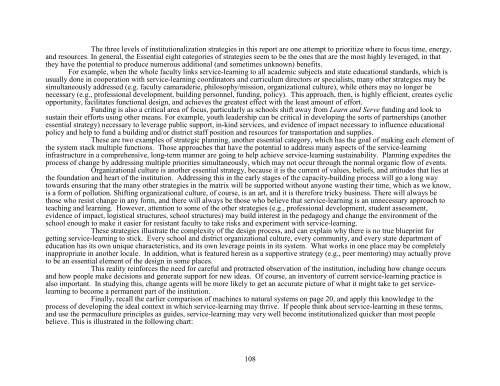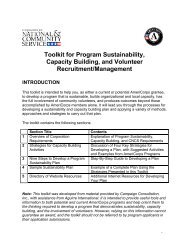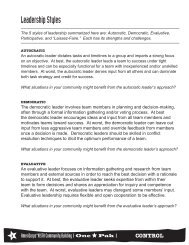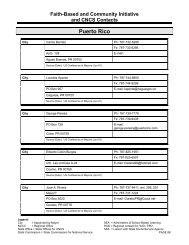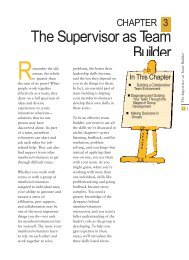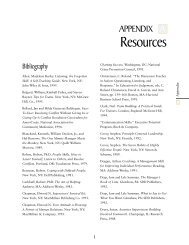MAKE IT LAST FOREVER: THE ... - National Service Resource Center
MAKE IT LAST FOREVER: THE ... - National Service Resource Center
MAKE IT LAST FOREVER: THE ... - National Service Resource Center
You also want an ePaper? Increase the reach of your titles
YUMPU automatically turns print PDFs into web optimized ePapers that Google loves.
The three levels of institutionalization strategies in this report are one attempt to prioritize where to focus time, energy,<br />
and resources. In general, the Essential eight categories of strategies seem to be the ones that are the most highly leveraged, in that<br />
they have the potential to produce numerous additional (and sometimes unknown) benefits.<br />
For example, when the whole faculty links service-learning to all academic subjects and state educational standards, which is<br />
usually done in cooperation with service-learning coordinators and curriculum directors or specialists, many other strategies may be<br />
simultaneously addressed (e.g. faculty camaraderie, philosophy/mission, organizational culture), while others may no longer be<br />
necessary (e.g., professional development, building personnel, funding, policy). This approach, then, is highly efficient, creates cyclic<br />
opportunity, facilitates functional design, and achieves the greatest effect with the least amount of effort.<br />
Funding is also a critical area of focus, particularly as schools shift away from Learn and Serve funding and look to<br />
sustain their efforts using other means. For example, youth leadership can be critical in developing the sorts of partnerships (another<br />
essential strategy) necessary to leverage public support, in-kind services, and evidence of impact necessary to influence educational<br />
policy and help to fund a building and/or district staff position and resources for transportation and supplies.<br />
These are two examples of strategic planning, another essential category, which has the goal of making each element of<br />
the system stack multiple functions. Those approaches that have the potential to address many aspects of the service-learning<br />
infrastructure in a comprehensive, long-term manner are going to help achieve service-learning sustainability. Planning expedites the<br />
process of change by addressing multiple priorities simultaneously, which may not occur through the normal organic flow of events.<br />
Organizational culture is another essential strategy, because it is the current of values, beliefs, and attitudes that lies at<br />
the foundation and heart of the institution. Addressing this in the early stages of the capacity-building process will go a long way<br />
towards ensuring that the many other strategies in the matrix will be supported without anyone wasting their time, which as we know,<br />
is a form of pollution. Shifting organizational culture, of course, is an art, and it is therefore tricky business. There will always be<br />
those who resist change in any form, and there will always be those who believe that service-learning is an unnecessary approach to<br />
teaching and learning. However, attention to some of the other strategies (e.g., professional development, student assessment,<br />
evidence of impact, logistical structures, school structures) may build interest in the pedagogy and change the environment of the<br />
school enough to make it easier for resistant faculty to take risks and experiment with service-learning.<br />
These strategies illustrate the complexity of the design process, and can explain why there is no true blueprint for<br />
getting service-learning to stick. Every school and district organizational culture, every community, and every state department of<br />
education has its own unique characteristics, and its own leverage points in its system. What works in one place may be completely<br />
inappropriate in another locale. In addition, what is featured herein as a supportive strategy (e.g., peer mentoring) may actually prove<br />
to be an essential element of the design in some places.<br />
This reality reinforces the need for careful and protracted observation of the institution, including how change occurs<br />
and how people make decisions and generate support for new ideas. Of course, an inventory of current service-learning practice is<br />
also important. In studying this, change agents will be more likely to get an accurate picture of what it might take to get servicelearning<br />
to become a permanent part of the institution.<br />
Finally, recall the earlier comparison of machines to natural systems on page 20, and apply this knowledge to the<br />
process of developing the ideal context in which service-learning may thrive. If people think about service-learning in these terms,<br />
and use the permaculture principles as guides, service-learning may very well become institutionalized quicker than most people<br />
believe. This is illustrated in the following chart:<br />
108


